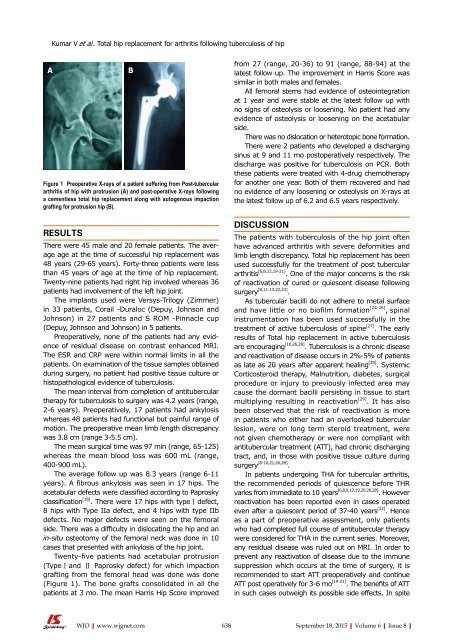You also want an ePaper? Increase the reach of your titles
YUMPU automatically turns print PDFs into web optimized ePapers that Google loves.
Kumar V et al . Total hip replacement for arthritis following tuberculosis <strong>of</strong> hip<br />
A<br />
RESULTS<br />
B<br />
Figure 1 Preoperative X-rays <strong>of</strong> a patient suffering from Post-tubercular<br />
arthritis <strong>of</strong> hip with protrusion (A) and post-operative X-rays following<br />
a cementless total hip replacement along with autogenous impaction<br />
grafting for protrusion hip (B).<br />
There were 45 male and 20 female patients. The average<br />
age at the time <strong>of</strong> successful hip replacement was<br />
48 years (29-65 years). Forty-three patients were less<br />
than 45 years <strong>of</strong> age at the time <strong>of</strong> hip replacement.<br />
Twenty-nine patients had right hip involved whereas 36<br />
patients had involvement <strong>of</strong> the left hip joint.<br />
The implants used were Versys-Trilogy (Zimmer)<br />
in 33 patients, Corail -Duraloc (Depuy, Johnson and<br />
Johnson) in 27 patients and S ROM -Pinnacle cup<br />
(Depuy, Johnson and Johnson) in 5 patients.<br />
Preoperatively, none <strong>of</strong> the patients had any evidence<br />
<strong>of</strong> residual disease on contrast enhanced MRI.<br />
The ESR and CRP were within normal limits in all the<br />
patients. On examination <strong>of</strong> the tissue samples obtained<br />
during surgery, no patient had positive tissue culture or<br />
histopathological evidence <strong>of</strong> tuberculosis.<br />
The mean interval from completion <strong>of</strong> antitubercular<br />
therapy for tuberculosis to surgery was 4.2 years (range,<br />
2-6 years). Preoperatively, 17 patients had ankylosis<br />
whereas 48 patients had functional but painful range <strong>of</strong><br />
motion. The preoperative mean limb length discrepancy<br />
was 3.8 cm (range 3-5.5 cm).<br />
The mean surgical time was 97 min (range, 65-125)<br />
whereas the mean blood loss was 600 mL (range,<br />
400-900 mL).<br />
The average follow up was 8.3 years (range 6-11<br />
years). A fibrous ankylosis was seen in 17 hips. The<br />
acetabular defects were classified according to Paprosky<br />
classification [18] . There were 17 hips with type Ⅰ defect,<br />
8 hips with Type IIa defect, and 4 hips with type IIb<br />
defects. No major defects were seen on the femoral<br />
side. There was a difficulty in dislocating the hip and an<br />
in-situ osteotomy <strong>of</strong> the femoral neck was done in 10<br />
cases that presented with ankylosis <strong>of</strong> the hip joint.<br />
Twenty-five patients had acetabular protrusion<br />
(Type Ⅰ and Ⅱ Paprosky defect) for which impaction<br />
grafting from the femoral head was done was done<br />
(Figure 1). The bone grafts consolidated in all the<br />
patients at 3 mo. The mean Harris Hip Score improved<br />
from 27 (range, 20-36) to 91 (range, 88-94) at the<br />
latest follow up. The improvement in Harris Score was<br />
similar in both males and females.<br />
All femoral stems had evidence <strong>of</strong> osteointegration<br />
at 1 year and were stable at the latest follow up with<br />
no signs <strong>of</strong> osteolysis or loosening. No patient had any<br />
evidence <strong>of</strong> osteolysis or loosening on the acetabular<br />
side.<br />
There was no dislocation or heterotopic bone formation.<br />
There were 2 patients who developed a discharging<br />
sinus at 9 and 11 mo postoperatively respectively. The<br />
discharge was positive for tuberculosis on PCR. Both<br />
these patients were treated with 4-drug chemotherapy<br />
for another one year. Both <strong>of</strong> them recovered and had<br />
no evidence <strong>of</strong> any loosening or osteolysis on X-rays at<br />
the latest follow up <strong>of</strong> 6.2 and 6.5 years respectively.<br />
DISCUSSION<br />
The patients with tuberculosis <strong>of</strong> the hip joint <strong>of</strong>ten<br />
have advanced arthritis with severe deformities and<br />
limb length discrepancy. Total hip replacement has been<br />
used successfully for the treatment <strong>of</strong> post tubercular<br />
arthritis [6,8,12,19-21] . One <strong>of</strong> the major concerns is the risk<br />
<strong>of</strong> reactivation <strong>of</strong> cured or quiescent disease following<br />
surgery [8,11-13,22,23] .<br />
As tubercular bacilli do not adhere to metal surface<br />
and have little or no bi<strong>of</strong>ilm formation [24-26] , spinal<br />
instrumentation has been used successfully in the<br />
treatment <strong>of</strong> active tuberculosis <strong>of</strong> spine [27] . The early<br />
results <strong>of</strong> Total hip replacement in active tuberculosis<br />
are encouraging [10,26,28] . Tuberculosis is a chronic disease<br />
and reactivation <strong>of</strong> disease occurs in 2%-5% <strong>of</strong> patients<br />
as late as 20 years after apparent healing [29] . Systemic<br />
Corticosteroid therapy, Malnutrition, diabetes, surgical<br />
procedure or injury to previously infected area may<br />
cause the dormant bacilli persisting in tissue to start<br />
multiplying resulting in reactivation [29] . It has also<br />
been observed that the risk <strong>of</strong> reactivation is more<br />
in patients who either had an overlooked tubercular<br />
lesion, were on long term steroid treatment, were<br />
not given chemotherapy or were non compliant with<br />
antitubercular treatment (ATT), had chronic discharging<br />
tract, and, in those with positive tissue culture during<br />
surgery [8-10,21,26,28] .<br />
In patients undergoing THA for tubercular arthritis,<br />
the recommended periods <strong>of</strong> quiescence before THR<br />
varies from immediate to 10 years [6,8,9,12,19,20,26,28] . However<br />
reactivation has been reported even in cases operated<br />
even after a quiescent period <strong>of</strong> 37-40 years [22] . Hence<br />
as a part <strong>of</strong> preoperative assessment, only patients<br />
who had completed full course <strong>of</strong> antitubercular therapy<br />
were considered for THA in the current series. Moreover,<br />
any residual disease was ruled out on MRI. In order to<br />
prevent any reactivation <strong>of</strong> disease due to the immune<br />
suppression which occurs at the time <strong>of</strong> surgery, it is<br />
recommended to start ATT preoperatively and continue<br />
ATT post operatively for 3-6 mo [19-21] . The benefits <strong>of</strong> ATT<br />
in such cases outweigh its possible side effects. In spite<br />
WJO|www.wjgnet.com 638<br />
September 18, 2015|Volume 6|Issue 8|


